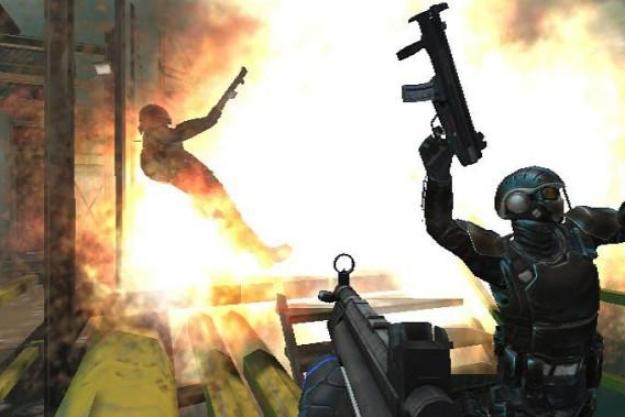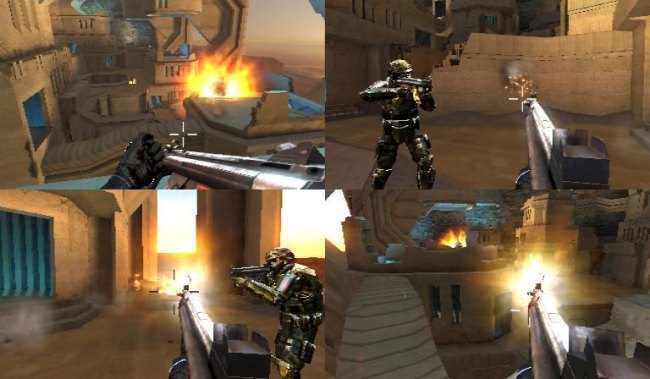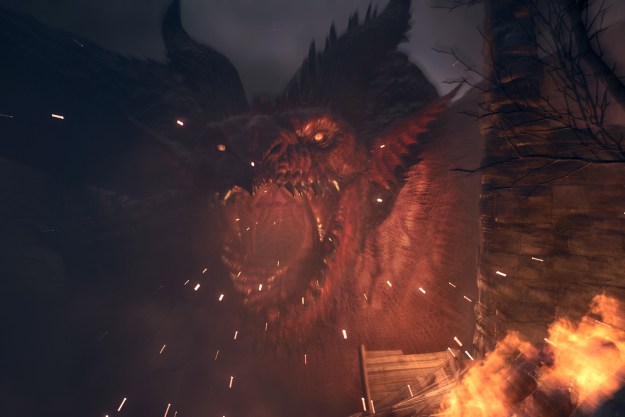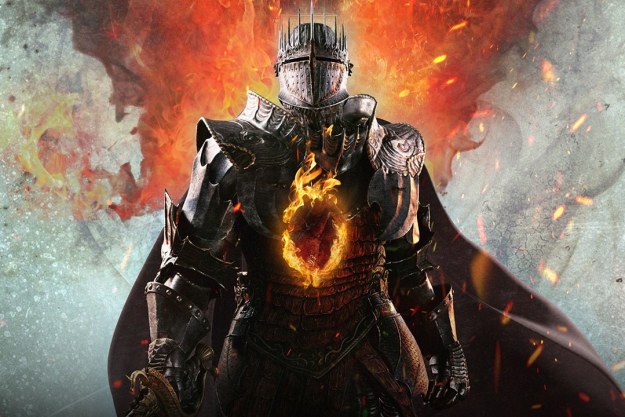
“Because it has no competition on the Wii, hardcore gamers will consider buying it.”
- One of the best Wii shooters, for what that's worth
- Wii controls offer a different type of game
- Generic level design
- Glitches
- Lame story
In some ways, I feel bad for High Voltage Software. With no notable Wii first-person games outside of the Metroid Prime series, the entire weight of the FPS genre rests on its shoulders. With The Conduit, the developer teamed with Sega and pulled off some impressive visuals on the Wii. Two years and a Roman fighting game later and the team has reunited for Conduit 2. The only problem is that this game takes its sequel status a little too seriously, with a series of rehashed levels, glitchy effects, and a storyline that isn’t worth mentioning.
Soldiers, robots, cloning, and aliens
For those uninitiated with the world of The Conduit, well, I’m not sure if you’re missing out or just lucky. High Voltage created the series because it saw a lack of good-looking games on the Wii—it was an opportunity, if you will. In the first game, you play as a special agent named Michael Ford who is betrayed by a bald coworker named John Adams (yes). Both are part of a government organization called Trust. Slight spoiler alert ahead, but it turns out that John Adams has cloned an army of aliens called the Drudge, and uses portals (called conduits) to transport them. He made this army by holding a single alien called Prometheus captive. At the end of the first game, Prometheus dies, but not before he merges his consciousness with yours.
I did not remember or care much about the first game’s story, but Conduit 2 picks up precisely where The Conduit leaves off. If you aren’t caught up, prepare to be slightly confused for the entire duration of the second game because there is no real recap. You’ll likely be bewildered as you transport around the globe following Adams and merging your soul with more alien bodies. But there plenty of soldiers, robots, and robot alien guard dogs to distract you between cut scenes.
If the alien dogs aren’t enough, High Voltage swapped voice actors for the primary character of Michael Ford. Mark A. Sheppard–best known for his work as a lawyer in Battlestar Galactica and a smuggler in Firefly –voiced Ford in the original game; now it’s Jon St. John, the man who voiced Duke Nukem. His dialogue has been appropriately overdramatized and cheesed up. Prometheus, Ford’s alien-inside-me counterpart, is also no longer Kevin Sorbo. I’m guessing these changes were made for budgetary reasons–the first Conduit only sold around 350,000 copies.
A Wii bit of control
Conduit 2 controls well for a first-person shooter on the Wii. The game is best played with a Wii Remote and Nunchuk: Looking is controlled by aiming at the screen while movement is tied to the analog control stick in your left hand. However, it still isn’t ideal. Though the Wii held such promise for shooters, only Metroid Prime, with its auto-enemy-lock system has delivered a superb experience on the platform. Midway through the first level, I got so annoyed at the control that I tried switching to a Wii Classic controller, which I thought would be as good as playing on an Xbox; it wasn’t. The Classic controller setup is no fun. It’s difficult to target enemies and many actions are downright unintuitive. It does do one thing though; it makes you thoroughly appreciate the motion controls when you return to them. I didn’t have much of a problem after I returned, due partly to my state of mind and partly to the increasingly simple level designs that permeate the latter half of the game.

For those of you willing to tinker, the game does offer complete control manipulation. You can alter the entire button layout and modify the sensitivity and freedom of movement on the Wii screen. If you want, you can probably try to make it play exactly like a PC FPS as well, where your screen moves in lock-step with your aiming. I don’t recommend it, however.
A Blast From the Past, Unfortunately
Conduit 2 is a fascinating title. During the course of the game, I felt like I actually re-experienced the last 10 years in first-person shooter gameplay evolution. And boy, we’ve come farther than I thought. If you play Goldeneye 007 on the Wii and compare it to the original Goldeneye 007 on the Nintendo 64, you’ll get the same feeling, except that Conduit 2 actually devolves as it progresses. The game starts out strong, like much of today’s highly scripted, highly automated first-person games. As you walk around an oil barge, a giant Godzilla-sized alien sea-snake (a leviathan) breaks apart the ship before your eyes. Enemies are eaten and everything is in a state of panic. To finish the level, you have to battle the super snake, which also offers a nice diversion from the conventional FPS gameplay. But then it just falls apart.
It’s as if, after making level one, High Voltage realized that it didn’t have time to continue making such a detailed, engaging game. After the first (long) level, the game seems to slowly devolve, become repetitive and lose its luster. You enter a room, fight off a half-dozen soldiers or aliens then you have to fulfill an objective by scanning some artifact with your ASE (All Seeing Eye). The second you do that, half a dozen more soldiers zipline down to kick your ass. That, or a bunch of tiny hobbit-sized robots will come and beat at your legs. They are annoying and difficult to kill, especially because melee attacks require you to thrust the Wii Remote forward, which has the unintended consequence of completely screwing up your aim. Try and shoot the buggers, if possible.

There are very few actual conduits (portals) in Conduit 2, but enemies still appear out of nowhere in areas you’ve already cleared. High Voltage does this to extend gameplay. If you have to travel through a level, then go backward and fight more guys on the long path out, it takes twice as long to cover ground. In one sequence, the game’s narrators actually point these game-lengthening maneuvers out, saying how building architects often construct rooms to be the same to save time, much like level designers do in “your Earth video games.”
As the levels progressed, I noticed a decline in the intelligence of enemies as well. Sometimes they seem to know exactly where you are, even if they shouldn’t have seen you yet, while other times you can shoot around them, throw grenades beside them and walk right up behind them and not get any reaction at all except a satisfying death animation when you plug them in the head. The same goes for their aim. Sometimes it’s great, sometimes it’s ridiculously bad. Nothing is stable.
A number of graphical glitches further mar gameplay. For example, if an enemy is a concrete floor above you, you can still see his shadow on the ground. In the last levels of the game, enemies like those damn robot dogs will actually disappear for a second or two at a time when the game throws too many of them at you, or they’re trying to perform complex maneuvers like… climbing up stairs and turning. Certain soldiers are locked up in Borg-like recharging stations as you approach them. When you fire on them, they are supposed to walk out of the station and start firing at you. Unfortunately, the unlocking animation glitches out sometimes, meaning they actually vanish and appear a few feet to the left or right, already cocked and ready to fire on you. Not cool, guys.
ASE and bosses
Repetitive level design and graphic glitches aside, it’s decently fun to drudge around and kill the drudge. However, aside from the first boss (the giant snake), most of the bosses (there are only two or three more) aren’t anything impressive. Mostly, they’re much-needed diversions from running around and shooting in the game’s increasingly generic China, Siberia, burned-out subway, and sunken robot spaceship levels. As you play these levels, you begin to wonder if there was any pre-thought game design or if High Voltage let its level designers go crazy and then tried to figure out how to create objectives and where to shove enemies and items. I began to get lost in the later levels from time to time. Though this is partially my fault, the lack of consistency between objects that you press with the A button and objects that you scan began to wear on me. Conduit 2, like its predecessor, has a scanning orb called an ASE you can bring up to uncover secrets and unlock consoles and such. When it’s brought up, it looks a lot like a heat-visor from Metroid Prime. Everything is in shades of purple except special items, which are bright orange.

Why does the scanning module exist? Aside from a few funny phrases etched onto walls like “our princess is in another castle,” I felt like I was scanning for the sake of it. From time to time, power consoles and doors are unlocked with the ASE, but the tiny lock icon for unlocking them is difficult to see. Other times, you just press the A button near a console to unlock a door. You can also scan “conspiracy objects,” which are usually just folders of paper laying on a table or the floor. The ASE made my head spin. Why can’t I just pick up the conspiracy papers by walking over them or pressing A? Why can’t all the doors just be unlocked without the ASE? I can understand why a game would have a visor, but the ASE doesn’t add anything to the experience. It only adds the appearance of depth. Now if I could scan a boss or enemy to figure out how to beat it, that might be useful. Unfortunately, this is usually pretty straight forward.
One last note on gameplay. Conduit 2 has a very fun level toward the end where you are on rails and shooting jetpacked soldiers and a plane out of the sky. It’s classic arcade play and it’s a lot of fun. It was technically a boss fight, but why was there only one level with this sort of play? It was such a pleasant diversion. I really wish High Voltage had explored unique new (or old) gameplay ideas more.
Multiplayer
What can I say except, it exists. After you finish the eight-or-so-hour campaign mode (it sure felt longer than that), the online multiplayer is a fun diversion. Up to 12 people can compete online on a variety of locales. Multiplayer modes include standard team against team, an Invasion mode where players fight off hordes of baddies together, and a couple other standard modes. Friend Codes are usable here and the game supports the PDP Headbanger Headset if you want to yell at your teammates. An “Ally System” feature lets you send friend request to people on your Wii friends list without having to send Friend codes for the game. When I booted the game up, I already had one multiplayer patch available. Others will likely be coming. Four-player splitscreen multiplayer is also available.

Conclusion
Conduit 2 feels rushed. It has glitches; its gameplay becomes increasingly boring, and the story is so silly it can hardly pass for a story at all. The game is extremely generic. If it were on any other system, it would be ignored completely, but because it has no competition on the Wii, hardcore gamers will consider buying it. If you like shooting things, there is plenty to shoot here. It’s all quite playable. The question is: if you’re spending $50, do you just want a game that’s playable, or do you want an experience you may actually remember and want to repeat? If quality is what you seek, elsewhere you must look. Not to beat on Metroid or Goldeneye 007 too much, but there ain’t many other options unless you get yourself an Xbox 360, PS3 or nice PC.
Score: 6.5
(This game was reviewed on the Nintendo Wii on a copy provided by Sega)
Editors' Recommendations
- Hades 2: release date prediction, trailers, gameplay, and more
- Frostpunk 2: release date, trailers, gameplay and more
- Nintendo Switch 2: release date rumors, features we want, and more
- Destiny 2: The Final Shape’s new subclass combines light and dark
- All upcoming Switch games: 2024, and beyond


